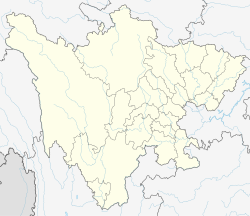Yanjiang
雁江区 | |
|---|---|
 | |
| Coordinates (Yanjiang District government): 30°06′28″N 104°40′37″E / 30.1079°N 104.6769°E | |
| Country | China |
| Province | Sichuan |
| Prefecture-level city | Ziyang |
| District seat | Baolian Subdistrict |
| Area | |
| • Total | 1,633 km2 (631 sq mi) |
| Population (2020 census)[1] | |
| • Total | 867,119 |
| • Density | 530/km2 (1,400/sq mi) |
| Time zone | UTC+8 (China Standard) |
| Website | www |
Yanjiang (Chinese: 雁江; pinyin: Yànjiāng) is the only district of the city of Ziyang, Sichuan Province, China. The district is located directly southeast of Chengdu. The district was established on June 14, 2000, by the State Council of China.[2]
History

Prior to the annexation by the Qin State, the area in the present-day Yanjiang District belonged to the Kingdom of Shu, and was part of the wider, but now extinct, Ba–Shu culture.[3]
Government
Administrative divisions
The Yanjiang District is divided into 5 subdistricts and 17 towns.[4] The district also hosts a labor camp, which is also included in population figures.[2][4]

- Subdistricts
- Lianhua Subdistrict (莲花街道)
- Sanxianci Subdistrict (三贤祠街道)
- Zixi Subdistrict (资溪街道)
- Shizishan Subdistrict (狮子山街道)
- Baolian Subdistrict (宝莲街道)
- Towns
- Yanjiang (雁江镇)
- Songtao (松涛镇)
- Baotai (宝台镇)
- Linjiang (临江镇)
- Baohe (保和镇)
- Laojun (老君镇)
- Zhonghe (中和镇)
- Danshan (丹山镇)
- Xiaoyuan (小院镇)
- Kanjia (堪嘉镇)
- Wuhuang (伍隍镇)
- Shiling (石岭镇)
- Dongfeng (东峰镇)
- Nanjin (南津镇)
- Fengyu (丰裕镇)
- Yingjie (迎接镇)
- Xiangfu (祥符镇)
Yanjiang District also is home to the Sichuan Dayan Labor Camp (四川大堰劳动教养管理所), which had a recorded population of 2,184 in 2010.[2][4]
Economy
The district recorded a GDP of 50.25 billion Chinese Yuan in 2018, an 8.1% increase from the previous year.[3] The following table shows a breakdown of the district's GDP:[5]
| Sector | 2018 Value (Yuan) | Percent of 2018 GDP | Percent Increase from 2017 |
|---|---|---|---|
| Primary Sector | 5.136 billion | 10.22% | 3.5% |
| Secondary Sector | 27.963 billion | 55.65% | 9.0% |
| Tertiary Sector | 17.149 billion | 34.13% | 8.1% |
| TOTAL | 50.248 billion | 100.00% | 8.1% |
Agriculture
As of 2018, the values of the district's agriculture, forestry, animal husbandry and fishing industries totaled 9.29 billion Yuan, a 3.6% increase from 2017.[5] Of this, the district's seeding industry's output totaled 4.62 billion Yuan, the forestry industry's totaled 0.49 billion, animal husbandry totaled 3.32 billion, fisheries totaled 0.31 billion, and fishing-related services totaled 0.55 billion.[5] The district government estimates that in 2018 alone, the district produced 85,000 tons of meat, farmed 72,000 hectares of land, and had a nursery area of 40 hectares.[5]
Telecommunications
At the end of 2018, the district reported 358,300 landline phones, 866,800 4G-capable mobile phones, and 450,500 broadband users.[5]
Tourism
In 2018, Yanjiang received 7.069 million domestic tourists, contributing 4.198 billion Yuan to the district's economy.[5] The district also received 43,300 foreign tourists in 2018, mostly from Hong Kong, Macau, and Taiwan, contributing 945,600 US Dollars to the district's economy.[5]
Demographics
According to the 2010 Chinese Census, Yanjiang District had a population of 905,729 people, down from 1,016,034 recorded in the 2000 Census.[2] The district government's website estimated that the population stood around 1,070,000 in 2019.[3]
Settlements
Largest cities or towns in Yanjiang
2010 Chinese Census | |||||||||
|---|---|---|---|---|---|---|---|---|---|
| Rank | Pop. | ||||||||
| 1 | Zixi Subdistrict | 83,356 | |||||||
| 2 | Lianhua Subdistrict | 78,374 | |||||||
| 3 | Sanxianci Subdistrict | 51,739 | |||||||
| 4 | Baohe Town | 40,978 | |||||||
| 5 | Wuhuang Town | 40,004 | |||||||
| 6 | Danshan Town | 39,793 | |||||||
| 7 | Shizishan Subdistrict | 39,696 | |||||||
| 8 | Laojun Town | 34,961 | |||||||
| 9 | Linjiang Town | 34,938 | |||||||
| 10 | Baotai Town | 34,005 | |||||||
Education
At the end of 2018, the district reported hosting 424 schools, of which, 276 were kindergartens, 81 were primary schools, 63 were secondary schools, and 3 were vocational secondary schools.[5]
Transportation
Road transport
As of 2018, Yanjiang District has a road network totaling 3,970.5 kilometers in length, of which, 82.3 kilometers were expressways.[5] In 2018, the district government recorded 54.52 million passenger trips on the district's roads, an 8.0% increase from 2017.[5] The district was home to road freight totaling a weight of 61.28 million tons, which was also an 8.0% from 2017.[5] Notable highways which pass through the district include the G76 Expressway, the S40 Suihong Expressway, the S106 Road, and China National Highway 321.
Maritime Transport
The district reported 2.39 million tons of freight transported via waterways in 2018, a 14.9% increase from 2017.[5] The main waterway in the district is the Tuo River.
References
- ^ "资阳市第七次全国人口普查公报(第二号)——县(区)人口情况" (in Chinese). Government of Dazhou. 2021-06-10.
- ^ a b c d 雁江区历史沿革_行政区划网(区划地名网) www.xzqh.org. XZQH.org. Retrieved 2020-04-12.
- ^ a b c 资阳市雁江区. Yanjiang District People's Government. Retrieved 2020-04-12.
- ^ a b c 2022年统计用区划代码. www.stats.gov.cn (in Chinese). 2022.
- ^ a b c d e f g h i j k l 资阳市雁江区. Yanjiang District People's Government. Retrieved 2020-04-12.

